As the bright planets march westward, Uranus and Neptune become the fresh new faces of fall. And if you've never seen an ultra-thin lunar crescent, here's your chance.
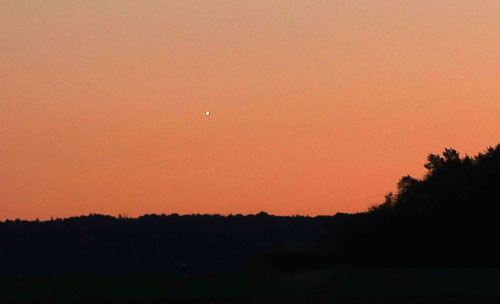
Bob King
It won't be long before the four bright evening planets dwindle to just one — Mars. Venus and Jupiter are already difficult to spot unless you've got an unobstructed view to the west-southwest. From the central U.S. Venus currently stands only about 3° high 15 minutes after sunset with Jupiter at 14°. Both are deeply buried in the twilight glow. Trees block sinking Saturn from my house, but Mars still dominates the southern sky even as it fades from magnitude –1.2 to –0.6 this month.
Meanwhile, Uranus and Neptune climb higher in the east. Befitting the cooler season, these outer planets harbor temperatures around –350°F (–212°C) at cloud-top level due to their enormous distances from the Sun (2.9 billion and 4.5 billion kilometers, respectively). Neptune, now 3 weeks past opposition in Aquarius, is comfortably placed for viewing as soon as the sky gets dark. Thanks to its northerly declination in Aries, we don't have to wait long to view Uranus either, which clears 25° before 10 o'clock local time despite opposition being nearly 3 weeks away (October 23rd).
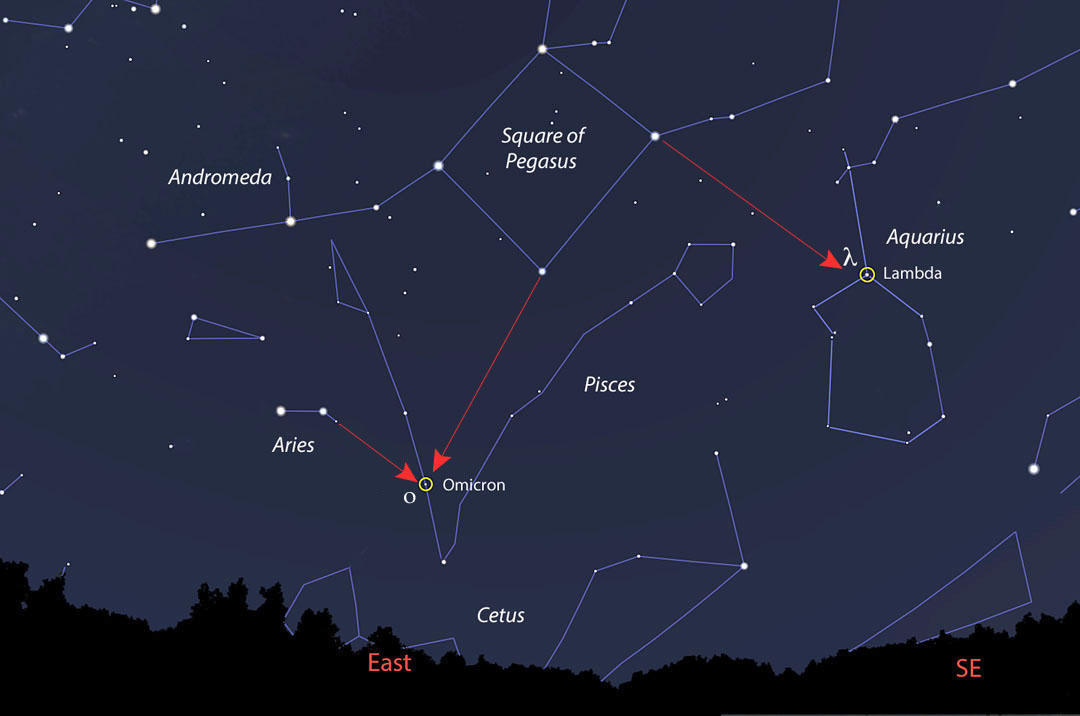
Stellarium
Because of their great distance and subsequent slow apparent motion, the two planets have occupied the same seasonal sky now for decades. Faster Uranus passed Neptune in Sagittarius in November 1993 and these ice giants have been slowly separating ever since. They won't pair up in conjunction again until January 2165.
Tracking down the fainter outer planets takes only a little more effort than seeing the bright ones. They're a nice change of pace after observing the many galaxies October brings to the table. At magnitude 5.7, Uranus is relatively easy to see with the naked eye from a rural sky once you know exactly where to look. I usually can spot it with averted vision on moonless nights once it climbs to a healthy altitude. How about Neptune?
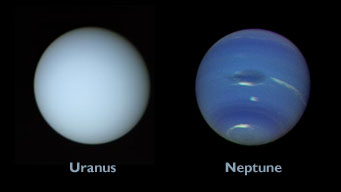
NASA
I've never seen it, nor do I know of any naked-eye observations, but according to the Bortle Dark-sky Scale, stars of magnitude 7.6–8.0 are visible to the suitably-trained naked eye. We'll assume we're looking relatively high up in the sky where atmospheric attenuation is a minimum. In that case Neptune, at magnitude 7.8, might be seen with averted vision. For most of us, getting to 6th magnitude is challenging enough, what with airglow and light pollution. That's why binoculars are so useful. With a typical 50-mm pair, you can pick out stars as faint as 10th magnitude, but factoring in light pollution and shakiness from hand-holding, the typical limit is closer magnitude 9.
If you switch to a telescope and use a magnification of 100× or higher, Uranus stands out clearly as a pale, blue-green disk 3.7″ (arcseconds) across. Seeing a planet four times bigger than Earth look so teeny helps us to appreciate how truly remote it is. Neptune looks bluer than Uranus to my eye and, of course, considerably smaller, just 2.3″ in diameter. I use a magnification of at least 200×–350× to see this pencil-point-wide planet.
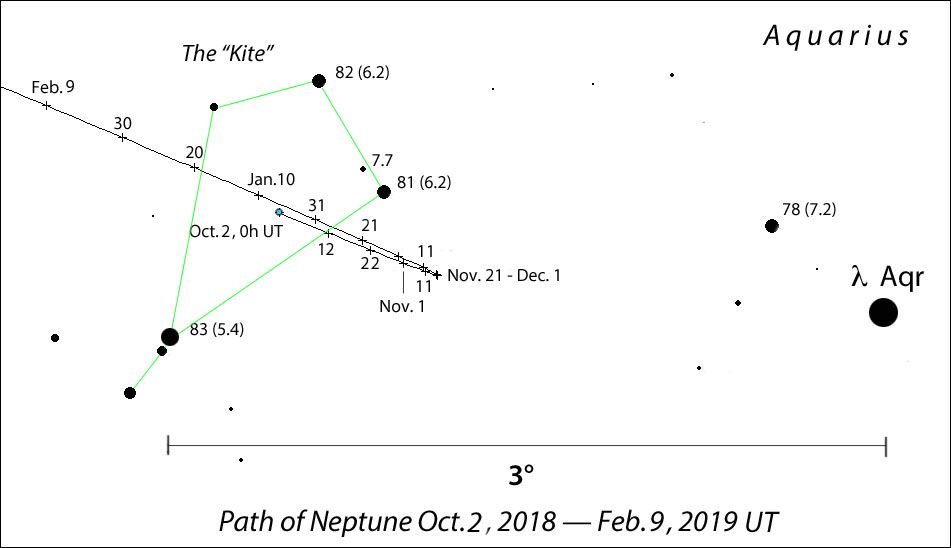
Chris Marriott's SkyMap with additions by the author
Those with 10-inch and larger telescopes can seek Neptune's largest and brightest moon, Triton. At magnitude 13.5, it's totally within range of even a smaller telescope, but challenging because its distance from the home planet varies from just 9″, when closest, to 14″ at greatest elongation over its 5.9-day orbit.
If you're lucky enough to get a few clear nights in a row, you'll appreciate Triton's truly unique qualities: it revolves backwards — counterclockwise around Neptune — and swings north or south of the planet at greatest elongation instead of east or west due to its steep orbital inclination. To cleanly separate planet from moon, I use a magnification of 220× or higher. Knowing just where to find the moon is easy with the Sky & Telescope Triton Tracker.
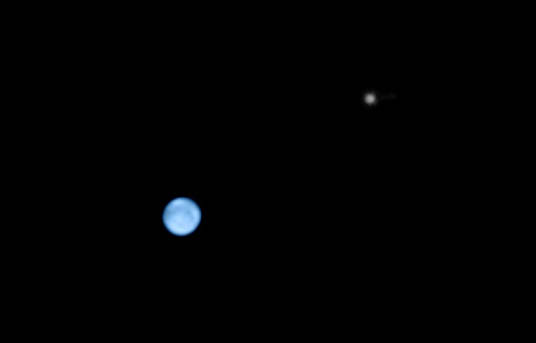
Damian Peach
Though closer to the Sun, the largest and brightest moons of Uranus, Titania and Oberon, are roughly half the size of Triton, with magnitudes as dim as 13.9 and 14.1, respectively. Their apparent distances at elongation are also considerably farther from the planet — 40″ for Oberon and 30″ for Titania. That might make you think they're easier catches than Triton, but just the opposite is true because Uranus is two magnitudes brighter than Neptune. That added glare gets in the way.
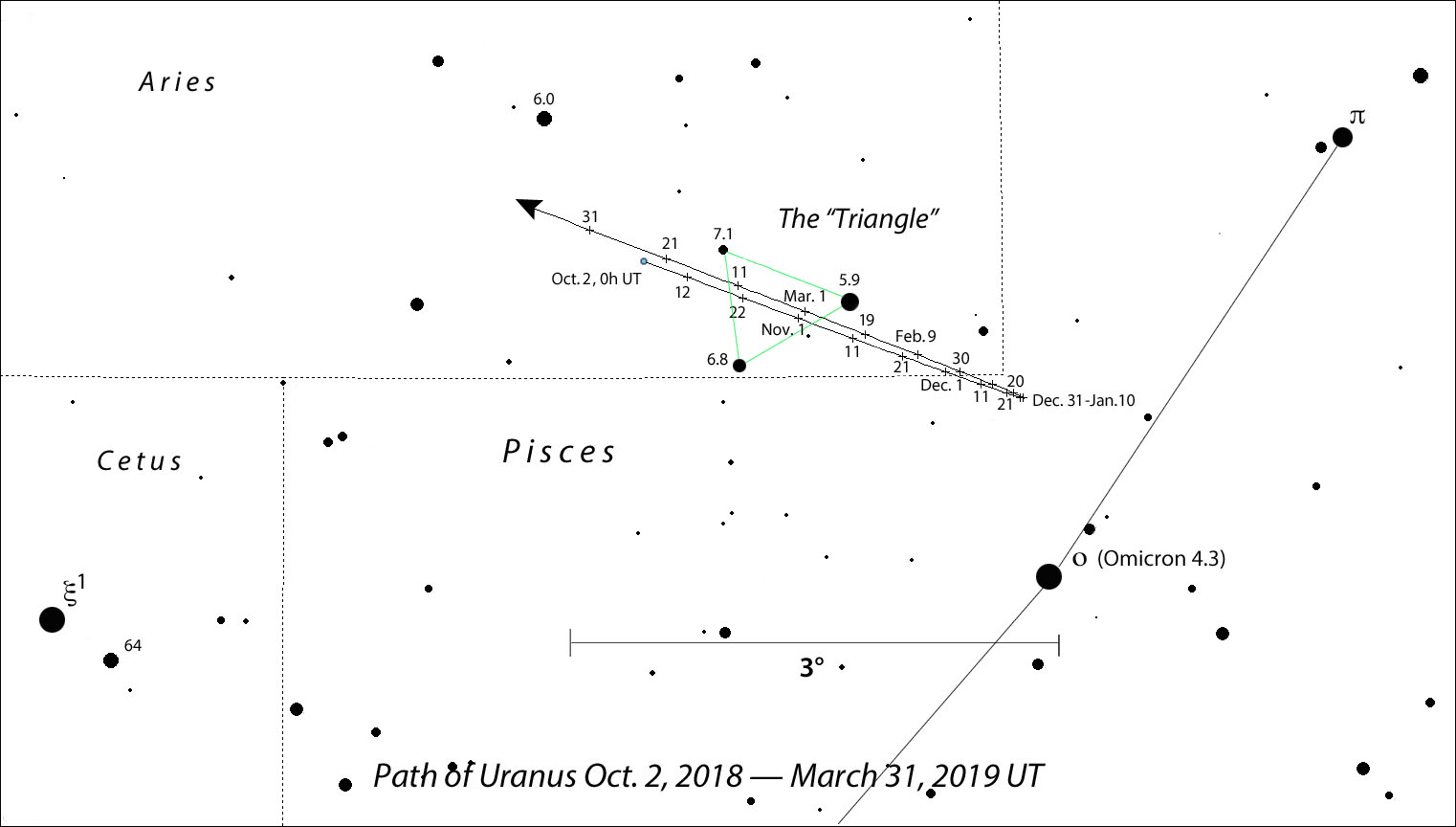
Chris Marriott's SkyMap with additions by the author
Still, under a moonless sky with Uranus well up in the east and a steady atmosphere, both these moons aren't too difficult to spot. Use the S&T Moons of Uranus tool to track them. I've seen both in scopes as small as 10 inches using 220× and higher. An occulting bar to block the light from the comparatively brilliant planet makes the task much easier. Ariel (magnitude 14.3) and Umbriel (15.0), which are closer in yet at just 18″ and 12″ at greatest elongation, are targets for 16-inch and larger telescopes. I've never positively identified Umbriel but about flipped out when I finally spotted Ariel a year ago in a friend's 24-inch.
While both planets will remain far apart for more than a century, Mars will share a close conjunction with each as it hurries east across the fall sky. The Red Planet passes only 2′ (arcminutes) north of Neptune on December 7th around 14h UT as seen from the eastern hemisphere. From the Americas, their separation will vary from 15′ to 11′ from the east coast to the west the evening of December 6th. On February 12, 2019, Mars glides 58′ north of Uranus.
Fast Facts
While you're out tracking down the planets and their moons, here's fuel for the imagination:
-
- Neptune has the strongest winds of any planet in the solar system. They’ve been clocked at over 2,100 km/hour. Scientists speculate the planet’s extreme cold, coupled with the fluidity of the gases in its atmosphere, reduces friction to very low levels, which allows the winds to reach incredible speeds.
- Neptune is the coldest planet in the solar system with temperatures dipping to –366°F (–221°C) in its upper atmosphere.
- With a diameter less than 1/30 the width of the full moon, the sun would be too small to see as a disk with the naked eye from Neptune but would still shine with the brightness of several hundred full Moons.
- At a depth of 7,000 kilometers, the temperature warms to between 3,140° and 8,540°F (1,725°–4725°C). Research suggests that the combination of high temperatures and pressures causes methane to transform into diamond dust that “rains” down onto Neptune's core.
- Because it revolves around the planet in the "wrong" direction, Triton is likely a captured asteroid.
- If you could fly to Uranus in a transcontinental jet at a cruising speed 550 mph, it would take 373 years to arrive.
- Uranus's axis is tilted 98°, so the planet orbits the Sun on its side with its poles periodically facing Earth. Each season on the planet lasts about 21 years. Either pole is plunged into complete darkness for 21 years during every orbit.
- Uranus and Neptune are known as “ice giants”. Eighty percent of their masses is made up of a hot, dense fluid of water, methane, and ammonia that envelopes a rocky core.
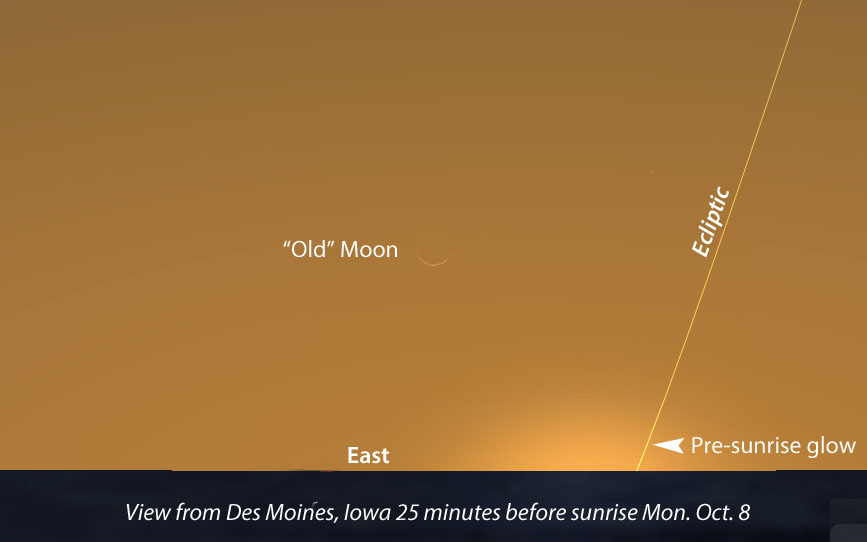
Stellarium
Observing Alert: Most thin crescent aficionados look for young Moons in the spring evening sky, but old October ones work just as well. A thin-as-air crescent Moon will rise shortly before the Sun on October 8th. From the East Coast, the Moon will be just 17 hours before new; 16 from the Midwest; 15 from the Mountain states, and 14 hours from the West Coast.
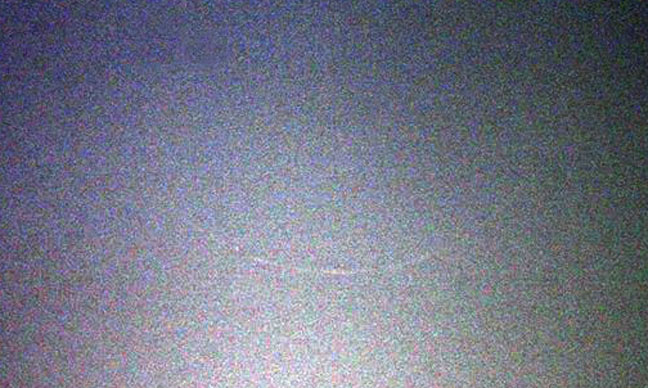
Ali Ebrahimi Seraji
If you're game, click here to get your local moonrise time, find a spot with as near as perfect an eastern horizon as possible (a lake is ideal), and start watching about 35 minutes before sunrise. The Moon will stand about 3.5° high some 20–25 minutes before sunrise from many locations in the Americas. This rare opportunity comes courtesy of the nearly perpendicular angle the ecliptic makes to the eastern horizon at dawn this month. Bring binoculars! If you see the crumbly crescent, please let us know.
Amateur astronomer Steven James O’Meara spied a 15-hour-32-minute crescent for the naked-eye record, while Mohsen G. Mirsaeed broke the record for youngest Moon ever seen with optical aid at 11 hours, 40 minutes. For more on thin moons (and more records!), click here.
 11
11









Comments
Anthony Barreiro
October 3, 2018 at 5:50 pm
"While both planets will remain far apart for more than a century, Mars will share a close conjunction with each as it hurries east across the fall sky. The Red Planet passes only 2′ (arcminutes) north of *Uranus* on December 7th ... "
Mars conjuncts *Neptune* on December 7.
You must be logged in to post a comment.
Bob KingPost Author
October 3, 2018 at 10:28 pm
Ooops! Looks like I said Uranus twice. Thanks, Anthony for pointing that out — now fixed. What is it about that planet's name?!
You must be logged in to post a comment.
Anthony Barreiro
October 4, 2018 at 3:37 pm
In his "Planets" suite, Gustav Holst called Uranus the Magician. Perhaps Uranus is also a trickster? 😉
https://www.youtube.com/watch?v=FK_QkS6uZeE
You must be logged in to post a comment.
Tom-Reiland
October 4, 2018 at 2:51 am
Unfortunately, when we talk about the planets in presentations to the public, people start to giggle when we mention Uranus. As I stated in one of my classes, it's too bad that the 3rd largest Planet in the Solar System is the butt of so many jokes. That gets a lot of groans. It's been a while since I observed Uranus without optical aid because of the increase of light pollution around Western Pennsylvania and my aging eyes. At least 20 years when I had access to an old farm in the Southwestern corner of Pa, I was able to observe the 4 brightest moons of Uranus with my 16" Dob. Titania and Oberon are the easiest and Umbriel was the most difficult. I've been able to spot 20 moons in our Solar System so far. I have friends who have viewed 2 or 3 more than I have. Triton is actually easier for me to observe than the moons of Uranus. My personal record for the youngest Moon observed is 20 hrs. Finally, this week, into early next week is a good time to look for Naked-eye Geostationary Satellites in Cetus, not far from Theta Ceti, starting around 2:20 AM up to 3:50, maybe 4 AM at the latest in the SW. I accidentally noticed this on the night of Oct 6/7, 2008 at Wagman Observatory. I thought it was a Nova, been then I saw a second one and realized what I was seeing. I counted 6 more that morning, plus several others that were visible in my 10 X 50 binoculars.. I hope to get a shot at it this week.
You must be logged in to post a comment.
Bob KingPost Author
October 4, 2018 at 1:47 pm
Hi Tom,
Thanks for the heads up on the geostationary satellites. I also was tricked into thinking for a few minutes that a geo was a nova. I think it was Galaxy 11 if memory serves. They really can get bright. I've seen flares to almost first magnitude. Also, I agree about Triton. It's easier because it's bright and Nepture is fainter.
You must be logged in to post a comment.
Chris-Schur
October 4, 2018 at 8:43 am
Too bad the thin moon is on a work day! 🙁
You must be logged in to post a comment.
Bob KingPost Author
October 4, 2018 at 1:51 pm
Hi Chris,
So true. But at least sunrise is relatively late now so getting up is less painful 🙂
You must be logged in to post a comment.
Joe Stieber
October 7, 2018 at 9:34 am
Here in southern New Jersey (near Philadelphia) at 40°N-75°W, the forecast for Monday morning, October 8, 2018, doesn't look very promising, but I'll be on standby just in case.
At this location, an interesting thing happens at sunset on October 8. Because of the Moon's approximate +4° ecliptic latitude, the old Moon sets shortly *after* the Sun on Monday evening. Sunset is at 6:31 pm EDT while Moonset is at 6:41 pm when it's still about 5 hours short of new at 11:47 pm. The Moon will be about 5° from the sun, so there's virtually no chance of seeing it, even if the weather is excellent since it will be well below the nominal 7° Danjon Limit.
Of course, that means the Moon will be about 19 hours old at sunset in my area on Tuesday evening, October 9, which is still a nice young Moon to catch! My personal bests are 20 hr 01 min old on February 3, 2011, and 19 hr 09 min before new on December 28, 2016 (both from sites essentially at sea level in a major metropolitan suburb). I'll have a chance to break my overall time from new on Tuesday as the Sun sets at 6:30 pm EDT when the Moon will be 18 hr 43 min old. Alas, it will likely be overcast, but again, I'll be on standby.
You must be logged in to post a comment.
Bob KingPost Author
October 7, 2018 at 10:04 pm
Hi Joe,
I know how it is to be on standby. Unfortunately, I can't even get that far. The forecast is solid overcast through Tuesday. I will have to wait for a next time, but I hope you get a break.
You must be logged in to post a comment.
Joe Stieber
October 11, 2018 at 3:59 am
Indeed, I was skunked by clouds on both Monday morning, Oct 8, and Tuesday evening, Oct 9. On Monday, it was clear around 3 am local EDT, but before 7:03 am sunrise, it had become heavily overcast with some fog. On Tuesday evening, the Sun popped out around 6 pm, so I had some optimism, but by sunset at 6:30 pm, clouds returned and a brief rain shower developed. Oh well.
I had my last “night” view of Venus on Sunday evening, Oct 7, about 10 minutes after sunset (wish I had gotten to my low-horizon site a bit earlier). With my 15x56 binoculars, it was murky along the western horizon and low Venus was a reddish, thick “banana,” too dim to see with unaided eyes. The previous Sunday, September 30, the crescent Venus was beautifully slim with the binoculars in a clear sky during early twilight, and was not difficult to spot with unaided eyes.
We had some clear blue sky between cumulus clouds the afternoon of Wednesday, Oct 10, and I was able to spot the crescent Venus with little difficulty using the 15x56s at 3 pm EDT. It was 53.7” diameter and 8.6% illuminated. I’ve seen Venus in daylight many times before, but it’s still amazes me to see its bright, silvery luster in the daytime. I couldn’t see it with unaided eyes though.
You must be logged in to post a comment.
Ali-Ebrahimi Seraji
August 23, 2019 at 11:38 am
Thanks for publishing the image. Hope you see more beautiful pictures of the crescent moon.
You must be logged in to post a comment.
You must be logged in to post a comment.